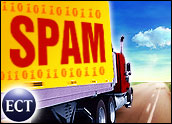
More than a year after the CAN-SPAM Act became law, e-mail users say they are receiving slightly more spam in their in boxes than before, but they are minding it less, according to a new survey.
Nevertheless, analysts warn that spam is a vehicle for worms, trojans and other malicious activity on the Internet that should not be treated lightly.
The Pew Internet & American Life Project report reveals 28 percent of users with a personal e-mail account said they are getting more spam than a year ago, while 22 percent say they are getting less. But only 67 percent of e-mail users said spam has made being online unpleasant or annoying, compared to 77 percent a year ago.
More Spam, Less Distress
“We see a little more spam with a little less distress since Congress tried to stem the flow of unsolicited e-mail with the CAN-SPAM Act in January 2004,” said Deborah Fallows, Senior Research Fellow at the Pew Internet Project. “Maybe people are getting used to spam, or becoming resigned to it, just like air pollution and crowded roads.”
In a first-time measure of phishing, unsolicited e-mail requesting personal financial information, 35 percent of those surveyed said they have received such e-mail, and 2 percent have responded by providing the information.
Fifty-three percent of e-mail users surveyed said spam has made them lesstrusting of e-mail, compared to 62 percent a year ago. Overall, more thanhalf of all Internet users complain that spam is a big problem.
Crime Online
Ken Dunham, the director of malicious code research at iDefense, a Reston, Va.-based threat intelligence firm, told the E-Commerce Times that spam is a major contributor to online crime.
“People get so many spam messages now that they are more likely to run through their e-mails quickly without discerning the viruses in attachments,” Dunham said. “Spam has contributed to the problem of user interaction worms.”
The CAN-SPAM Act does appear to have made an impact on porn spam. The Pewsurvey found that people are getting less of this uniquely troubling form ofspam.
Porn Curbed
While 63 percent of e-mail users now said they have received porn spam, down 8percentage points from a year ago, 29 percent of those e-mail users say they are now getting less porn spam, compared to 16 percent who said they are getting more.
In further findings, more e-mail users have reacted positively to the unprecedented use of e-mail in political campaigns over the past year. In June, 2003, 74 percent of e-mailers considered “unsolicited e-mail from a political or advocacy group” to be spam, but by January, 2005, that number had dropped significantly to 66 percent.





















































